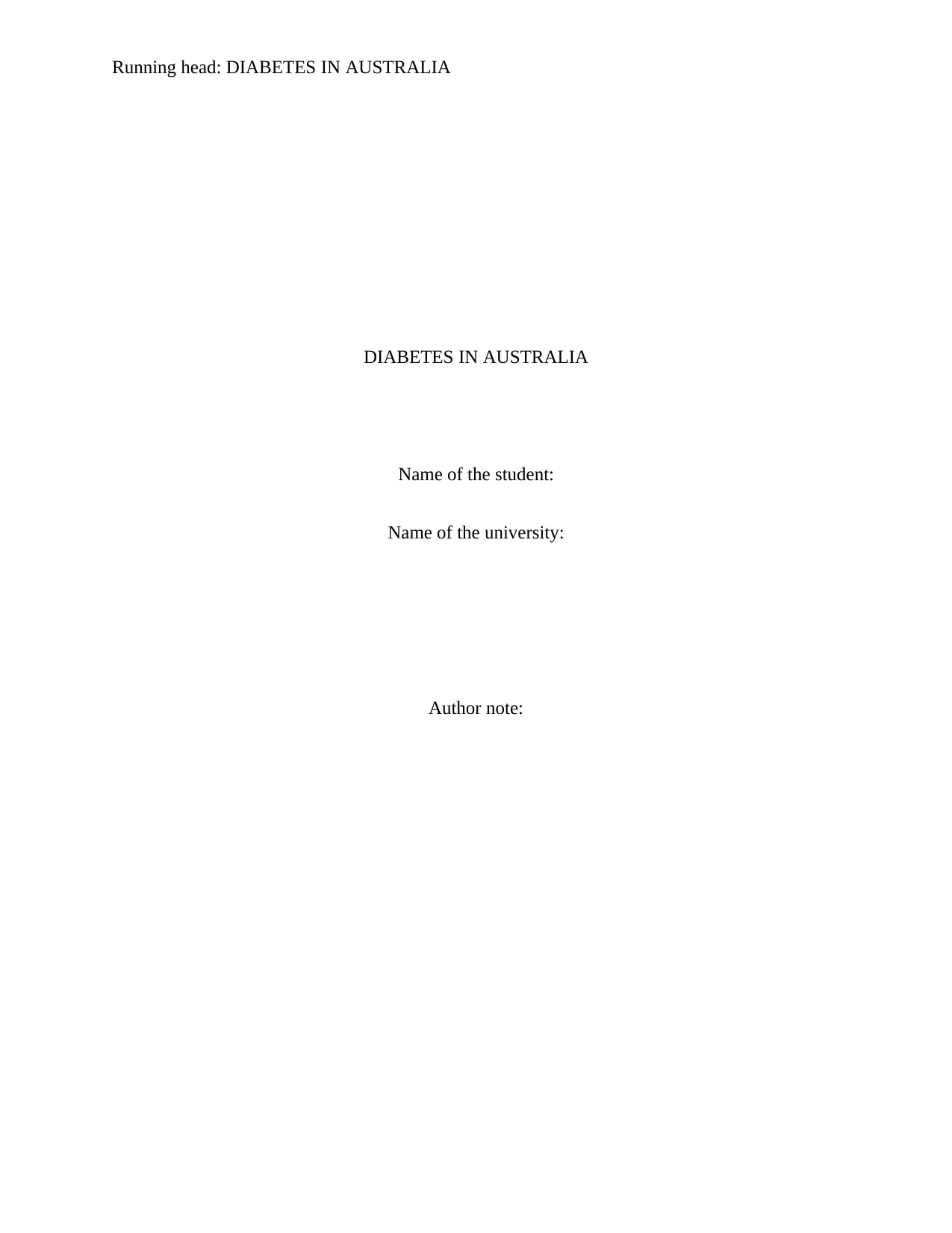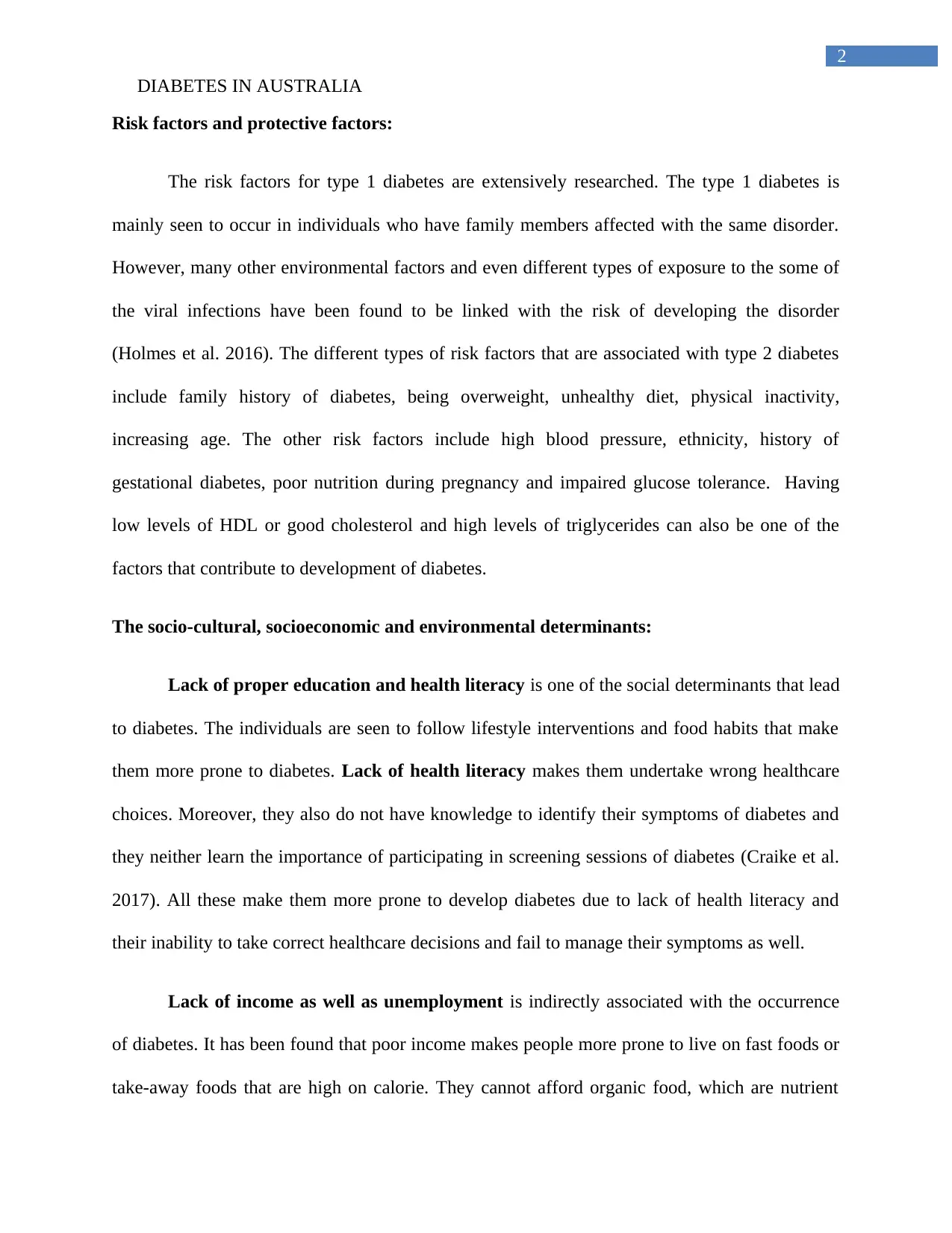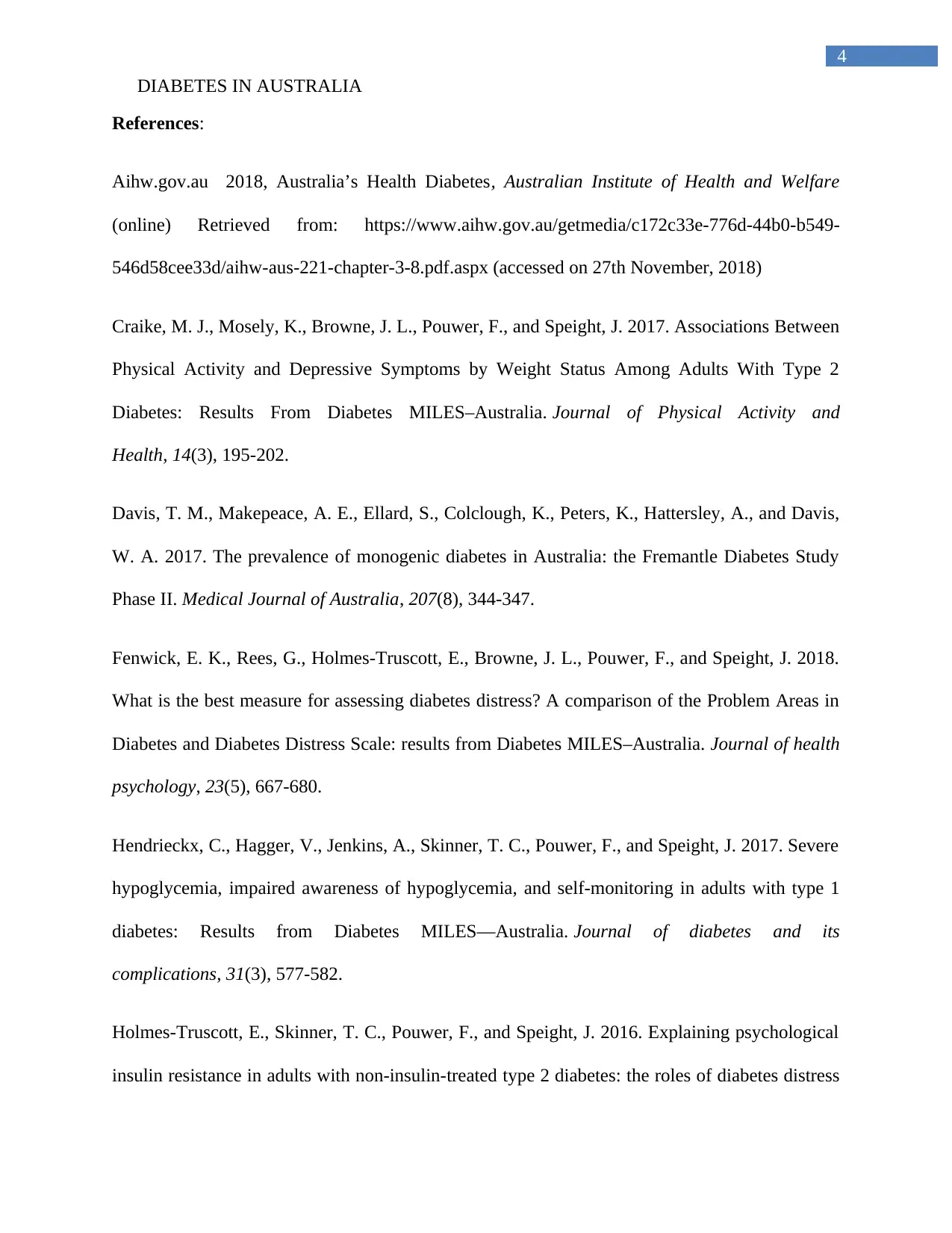Diabetes in Australia: Health Priorities and Analysis
VerifiedAdded on 2023/05/30
|6
|1377
|442
Report
AI Summary
This report provides a comprehensive analysis of diabetes in Australia, addressing it as a significant health priority. It delves into the prevalence of diabetes, highlighting statistics from the Australian Bureau of Statistics and the Australian Institute of Health and Welfare, which reveal the extent of the pr...

Running head: DIABETES IN AUSTRALIA
DIABETES IN AUSTRALIA
Name of the student:
Name of the university:
Author note:
DIABETES IN AUSTRALIA
Name of the student:
Name of the university:
Author note:
Paraphrase This Document
Need a fresh take? Get an instant paraphrase of this document with our AI Paraphraser

1
DIABETES IN AUSTRALIA
Diabetes:
Diabetes can be defined as the chronic condition, which occurs by the higher levels of
sugar in the blood. It is caused when the beta cells of the Langerhans of the pancreas stops
secreting insulin that helps in controlling the blood sugar level. The insulin hormone helps the
cells receptive of the glucose present in the blood for respiration and in this way controls the
blood sugar level of the body (Fenwick et al. 2018). When the individuals develop diabetes, the
insulin can no longer make the cells receptive to glucose and hence the cells can no longer take
any more glucose. The glucose concentration increases in the blood and this situation results in
various metabolic and physiological disorders. Various complications remain associated with
this disorder making the affected individuals suffer from poor quality life and many life-
threatening situations (Davis et al. 2017).
Extent of the problem:
The Australian Bureau of statistics 2014 to 2015 national health survey has stated that
more than one in every 20 Australian adults accounting for about 6.1% of 1.2 million people
suffers from diabetes. An estimated number of about 1 in every 5 Australian adults aged 75 and
more accounting for about 19% are seen to be suffering from diabetes in the year 2014-2015 in
comparison to that of 1.3 % of people belonging to the age cohort of 18 to 44. Diabetes was
found to be the underlying cause of around 4770 deaths in the year of 2016 (aihw.gov.au 2018).
It had led to about 16450 deaths that accounted for about 10% of all the types of death in the
nation. It has been seen that around the time between 2009 and 2014, the deaths due to type 1
diabetes had reduced by 20% but rose by 10% for people with type 2 diabetes.
DIABETES IN AUSTRALIA
Diabetes:
Diabetes can be defined as the chronic condition, which occurs by the higher levels of
sugar in the blood. It is caused when the beta cells of the Langerhans of the pancreas stops
secreting insulin that helps in controlling the blood sugar level. The insulin hormone helps the
cells receptive of the glucose present in the blood for respiration and in this way controls the
blood sugar level of the body (Fenwick et al. 2018). When the individuals develop diabetes, the
insulin can no longer make the cells receptive to glucose and hence the cells can no longer take
any more glucose. The glucose concentration increases in the blood and this situation results in
various metabolic and physiological disorders. Various complications remain associated with
this disorder making the affected individuals suffer from poor quality life and many life-
threatening situations (Davis et al. 2017).
Extent of the problem:
The Australian Bureau of statistics 2014 to 2015 national health survey has stated that
more than one in every 20 Australian adults accounting for about 6.1% of 1.2 million people
suffers from diabetes. An estimated number of about 1 in every 5 Australian adults aged 75 and
more accounting for about 19% are seen to be suffering from diabetes in the year 2014-2015 in
comparison to that of 1.3 % of people belonging to the age cohort of 18 to 44. Diabetes was
found to be the underlying cause of around 4770 deaths in the year of 2016 (aihw.gov.au 2018).
It had led to about 16450 deaths that accounted for about 10% of all the types of death in the
nation. It has been seen that around the time between 2009 and 2014, the deaths due to type 1
diabetes had reduced by 20% but rose by 10% for people with type 2 diabetes.

2
DIABETES IN AUSTRALIA
Risk factors and protective factors:
The risk factors for type 1 diabetes are extensively researched. The type 1 diabetes is
mainly seen to occur in individuals who have family members affected with the same disorder.
However, many other environmental factors and even different types of exposure to the some of
the viral infections have been found to be linked with the risk of developing the disorder
(Holmes et al. 2016). The different types of risk factors that are associated with type 2 diabetes
include family history of diabetes, being overweight, unhealthy diet, physical inactivity,
increasing age. The other risk factors include high blood pressure, ethnicity, history of
gestational diabetes, poor nutrition during pregnancy and impaired glucose tolerance. Having
low levels of HDL or good cholesterol and high levels of triglycerides can also be one of the
factors that contribute to development of diabetes.
The socio-cultural, socioeconomic and environmental determinants:
Lack of proper education and health literacy is one of the social determinants that lead
to diabetes. The individuals are seen to follow lifestyle interventions and food habits that make
them more prone to diabetes. Lack of health literacy makes them undertake wrong healthcare
choices. Moreover, they also do not have knowledge to identify their symptoms of diabetes and
they neither learn the importance of participating in screening sessions of diabetes (Craike et al.
2017). All these make them more prone to develop diabetes due to lack of health literacy and
their inability to take correct healthcare decisions and fail to manage their symptoms as well.
Lack of income as well as unemployment is indirectly associated with the occurrence
of diabetes. It has been found that poor income makes people more prone to live on fast foods or
take-away foods that are high on calorie. They cannot afford organic food, which are nutrient
DIABETES IN AUSTRALIA
Risk factors and protective factors:
The risk factors for type 1 diabetes are extensively researched. The type 1 diabetes is
mainly seen to occur in individuals who have family members affected with the same disorder.
However, many other environmental factors and even different types of exposure to the some of
the viral infections have been found to be linked with the risk of developing the disorder
(Holmes et al. 2016). The different types of risk factors that are associated with type 2 diabetes
include family history of diabetes, being overweight, unhealthy diet, physical inactivity,
increasing age. The other risk factors include high blood pressure, ethnicity, history of
gestational diabetes, poor nutrition during pregnancy and impaired glucose tolerance. Having
low levels of HDL or good cholesterol and high levels of triglycerides can also be one of the
factors that contribute to development of diabetes.
The socio-cultural, socioeconomic and environmental determinants:
Lack of proper education and health literacy is one of the social determinants that lead
to diabetes. The individuals are seen to follow lifestyle interventions and food habits that make
them more prone to diabetes. Lack of health literacy makes them undertake wrong healthcare
choices. Moreover, they also do not have knowledge to identify their symptoms of diabetes and
they neither learn the importance of participating in screening sessions of diabetes (Craike et al.
2017). All these make them more prone to develop diabetes due to lack of health literacy and
their inability to take correct healthcare decisions and fail to manage their symptoms as well.
Lack of income as well as unemployment is indirectly associated with the occurrence
of diabetes. It has been found that poor income makes people more prone to live on fast foods or
take-away foods that are high on calorie. They cannot afford organic food, which are nutrient
⊘ This is a preview!⊘
Do you want full access?
Subscribe today to unlock all pages.

Trusted by 1+ million students worldwide

3
DIABETES IN AUSTRALIA
rich. Therefore, they tend to develop obesity due to gaining of more calories. As they gain more
weight, fats are accumulated that affect the receptors of the cell and make the cells of the body
intolerant towards insulin (Hendrieckx et al. 2017). Hence, obesity results that in turn lead to
diabetes in such cohort of people. Similar have been the cases of people suffering from poverty
and belonging to low socioeconomic background.
The obesogenic environment is also another factor that is affecting the people of the
nation making them vulnerable to develop the disorders. The advertisements of fast foods and
beverages shown on television, radio, social media and many others have become the easiest
source of information and attraction of people of various cohorts. Moreover, the academic and
professional pressures have also ad elves of people more sedentary and they cannot undertake
any physical exercises. This makes people more prone to develop obesity, which is one of the
most important contributing risk factor for development of diabetes (Craike et al. 2017).
Groups at risk:
Older people make up a considerable portion of the population of Australia. In the year
2017, about one in every 7 people who were aged above 65 and more were found to be affected
with the disorder. Therefore, the cohort of older citizen can be discussed as the group, which is
mostly at risk for diabetes (Holmes et al. 2016).
Conclusion:
From the above discussion, it can be concluded that diabetes is becoming one of the most
concerning disorder in the nation resulting in increase of disease burden. Therefore, healthcare
professionals need to take appropriate interventions to assure better future and healthy lives for
all citizens in the nation.
DIABETES IN AUSTRALIA
rich. Therefore, they tend to develop obesity due to gaining of more calories. As they gain more
weight, fats are accumulated that affect the receptors of the cell and make the cells of the body
intolerant towards insulin (Hendrieckx et al. 2017). Hence, obesity results that in turn lead to
diabetes in such cohort of people. Similar have been the cases of people suffering from poverty
and belonging to low socioeconomic background.
The obesogenic environment is also another factor that is affecting the people of the
nation making them vulnerable to develop the disorders. The advertisements of fast foods and
beverages shown on television, radio, social media and many others have become the easiest
source of information and attraction of people of various cohorts. Moreover, the academic and
professional pressures have also ad elves of people more sedentary and they cannot undertake
any physical exercises. This makes people more prone to develop obesity, which is one of the
most important contributing risk factor for development of diabetes (Craike et al. 2017).
Groups at risk:
Older people make up a considerable portion of the population of Australia. In the year
2017, about one in every 7 people who were aged above 65 and more were found to be affected
with the disorder. Therefore, the cohort of older citizen can be discussed as the group, which is
mostly at risk for diabetes (Holmes et al. 2016).
Conclusion:
From the above discussion, it can be concluded that diabetes is becoming one of the most
concerning disorder in the nation resulting in increase of disease burden. Therefore, healthcare
professionals need to take appropriate interventions to assure better future and healthy lives for
all citizens in the nation.
Paraphrase This Document
Need a fresh take? Get an instant paraphrase of this document with our AI Paraphraser

4
DIABETES IN AUSTRALIA
References:
Aihw.gov.au 2018, Australia’s Health Diabetes, Australian Institute of Health and Welfare
(online) Retrieved from: https://www.aihw.gov.au/getmedia/c172c33e-776d-44b0-b549-
546d58cee33d/aihw-aus-221-chapter-3-8.pdf.aspx (accessed on 27th November, 2018)
Craike, M. J., Mosely, K., Browne, J. L., Pouwer, F., and Speight, J. 2017. Associations Between
Physical Activity and Depressive Symptoms by Weight Status Among Adults With Type 2
Diabetes: Results From Diabetes MILES–Australia. Journal of Physical Activity and
Health, 14(3), 195-202.
Davis, T. M., Makepeace, A. E., Ellard, S., Colclough, K., Peters, K., Hattersley, A., and Davis,
W. A. 2017. The prevalence of monogenic diabetes in Australia: the Fremantle Diabetes Study
Phase II. Medical Journal of Australia, 207(8), 344-347.
Fenwick, E. K., Rees, G., Holmes-Truscott, E., Browne, J. L., Pouwer, F., and Speight, J. 2018.
What is the best measure for assessing diabetes distress? A comparison of the Problem Areas in
Diabetes and Diabetes Distress Scale: results from Diabetes MILES–Australia. Journal of health
psychology, 23(5), 667-680.
Hendrieckx, C., Hagger, V., Jenkins, A., Skinner, T. C., Pouwer, F., and Speight, J. 2017. Severe
hypoglycemia, impaired awareness of hypoglycemia, and self-monitoring in adults with type 1
diabetes: Results from Diabetes MILES—Australia. Journal of diabetes and its
complications, 31(3), 577-582.
Holmes-Truscott, E., Skinner, T. C., Pouwer, F., and Speight, J. 2016. Explaining psychological
insulin resistance in adults with non-insulin-treated type 2 diabetes: the roles of diabetes distress
DIABETES IN AUSTRALIA
References:
Aihw.gov.au 2018, Australia’s Health Diabetes, Australian Institute of Health and Welfare
(online) Retrieved from: https://www.aihw.gov.au/getmedia/c172c33e-776d-44b0-b549-
546d58cee33d/aihw-aus-221-chapter-3-8.pdf.aspx (accessed on 27th November, 2018)
Craike, M. J., Mosely, K., Browne, J. L., Pouwer, F., and Speight, J. 2017. Associations Between
Physical Activity and Depressive Symptoms by Weight Status Among Adults With Type 2
Diabetes: Results From Diabetes MILES–Australia. Journal of Physical Activity and
Health, 14(3), 195-202.
Davis, T. M., Makepeace, A. E., Ellard, S., Colclough, K., Peters, K., Hattersley, A., and Davis,
W. A. 2017. The prevalence of monogenic diabetes in Australia: the Fremantle Diabetes Study
Phase II. Medical Journal of Australia, 207(8), 344-347.
Fenwick, E. K., Rees, G., Holmes-Truscott, E., Browne, J. L., Pouwer, F., and Speight, J. 2018.
What is the best measure for assessing diabetes distress? A comparison of the Problem Areas in
Diabetes and Diabetes Distress Scale: results from Diabetes MILES–Australia. Journal of health
psychology, 23(5), 667-680.
Hendrieckx, C., Hagger, V., Jenkins, A., Skinner, T. C., Pouwer, F., and Speight, J. 2017. Severe
hypoglycemia, impaired awareness of hypoglycemia, and self-monitoring in adults with type 1
diabetes: Results from Diabetes MILES—Australia. Journal of diabetes and its
complications, 31(3), 577-582.
Holmes-Truscott, E., Skinner, T. C., Pouwer, F., and Speight, J. 2016. Explaining psychological
insulin resistance in adults with non-insulin-treated type 2 diabetes: the roles of diabetes distress

5
DIABETES IN AUSTRALIA
and current medication concerns. Results from Diabetes MILES—Australia. Primary care
diabetes, 10(1), 75-82.
DIABETES IN AUSTRALIA
and current medication concerns. Results from Diabetes MILES—Australia. Primary care
diabetes, 10(1), 75-82.
⊘ This is a preview!⊘
Do you want full access?
Subscribe today to unlock all pages.

Trusted by 1+ million students worldwide
1 out of 6
Related Documents
Your All-in-One AI-Powered Toolkit for Academic Success.
+13062052269
info@desklib.com
Available 24*7 on WhatsApp / Email
![[object Object]](/_next/static/media/star-bottom.7253800d.svg)
Unlock your academic potential
© 2024 | Zucol Services PVT LTD | All rights reserved.





